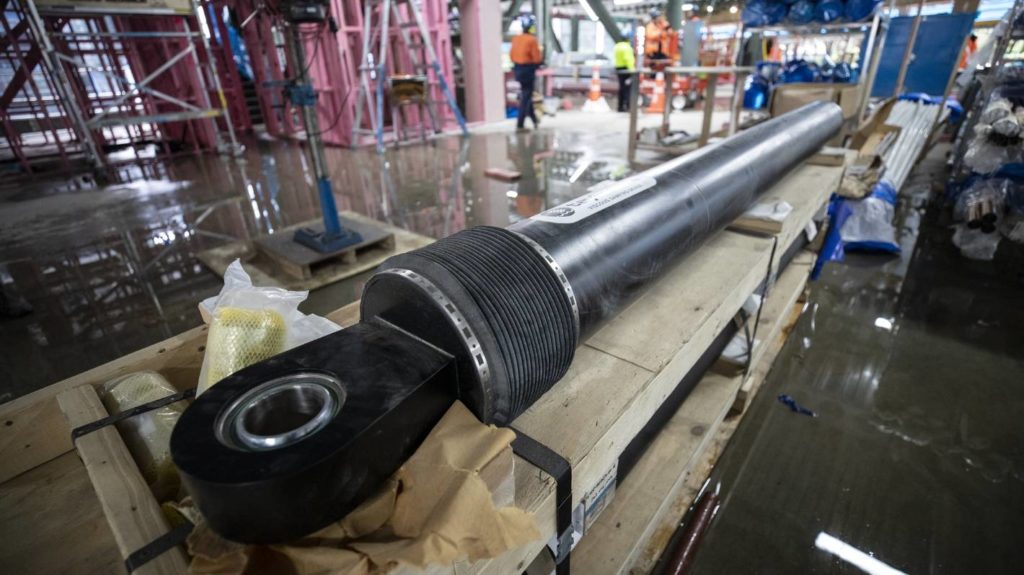It might look like a normal construction site from the outside, but a new office development near Parliament is packed with earthquake-resistant technology never seen before in the capital.
The Bowen Campus, being developed Precinct Properties, consists of two earthquake-resilient buildings, being built at a cost of $160 million.
Each of the Bowen St buildings uses 64 seismic dampers – cylinders with a piston inside surrounded by silicone-based fluid that are fixed horizontally onto the structural frame. There are eight dampers for each floor.
Nick Morris, the project lead for construction firm LT McGuinness, said the viscous dampers acted like car shock absorbers for the building during an earthquake.
READ MORE:
* Precinct Properties commits to new $90m building on Bowen Campus after securing tenants
* Rents in new earthquake-resilient Wellington buildings could top $800 a square metre, real estate firm says
* Two new earthquake-resilient buildings costing $160 million announced for Wellington
MONIQUE FORD/Stuff
The seismic dampers are cylinders with a piston inside surrounded by silicone-based fluid.
The basic design principle was that the dampers converted kinetic energy from an earthquake into thermal energy by heating fluid, and that heat then dissipated into the ceiling space, Morris said.
“They accommodate the movements that the building would receive in the event of an earthquake.”
Wellington is an active seismic zone, with its buildings facing an increased risk of destructive shaking during an earthquake.
Up to 150 central city buildings in the capital are deemed an earthquake risk, including Mātauranga House in Bowen St where the Ministry of Education was located. More than 1000 Ministry staff were forced to work from home when their office was closed in May.
The building, which was previously strengthened above 90% of the New Building Standard (NBS), is now rated by engineers at 25% NBS, due to its concrete floors.
MONIQUE FORD/Stuff
Project lead Nick Morris,left, and Kevin Pugh of Precinct Properties. A damper is installed above.
Compared with other earthquake-resistant technologies, seismic dampers kick in once an earthquake happens, and there are fewer concerns for the building’s tenants in the aftermath. They were chosen for their simplicity and to suit the site’s topography and the building’s size.
“There’s nothing to replace or repair after an earthquake,” Morris said. “[It only needs] a quick check to make sure there’s no visual damage or any fluid leaking, and then it’s business as usual for the building’s tenants.”
The dampers were made in Buffalo, New York, and installing them required precision, Morris said.
Placeholders for the dampers were used when the building was built. When the dampers arrived, the placeholders were taken out and the dampers were then held in place with a locking pin.
MONIQUE FORD/Stuff
There are 64 seismic dampers throughout the Bowen Campus development, with eight installed on each floor.
“I have to say the tolerance on all that kit is very tight, like the pin that goes in is built to a tolerance of 0.003 mm,” he said. “It’s like aerospace kind of tolerances that we’re using here.”
Dr David Whittaker, a former president of the New Zealand Society for Earthquake Engineering, said the difference between viscous dampers and base isolators, the seismic technology that is used in Wellington buildings such as Te Papa and Parliament, was just where they were located.
Base isolators sit below a building to allow the ground to move underneath it during an earthquake, while viscous dampers are distributed over the height of a building.
“Fundamentally, the principles of them are similar because they absorb energy,” he said.
Precinct Properties chief executive Scott Pritchard said it was non-negotiable to have earthquake-proof building designs, but tenants now wanted business continuity alongside health and safety standards.
“The buildings that we’re building now can withstand a really significant shake, and then be able to operate immediately afterwards.”
The development is expected to be completed later this year, with about three quarters of the space available to let leased to accounting firm EY and Japanese multinational Fujitsu.
MONIQUE FORD/Stuff
The Bowen Campus development is expected to be completed later this year.
